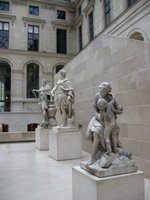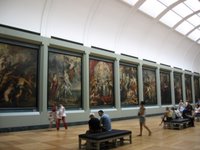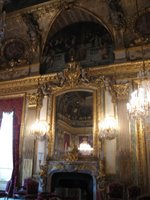Le Louvre is a HUGE museum! The square in front of Le Louvre forms a continuous stretch of open space with the adjacent Jardin des Tuileries. The glass pyramid designed by the architect I. M. Peh lies in the centre of the square, surrounded by a few fountains. The pyramid is only the entrance to the Museum; the exhibitions are actually housed in the three buildings around the square. The inside of those 3 buildings is like a maze!
What’s there in Le Louvre that draws in so many tourists? First, there’s the famous resident Mona Lisa. Her gentle smile exerts an inexplicable force attracting the trail and attention of visitors who come to admire and lavish praises on her. There is also a voluminous amount of other exhibits that cater for all sorts of interests. My friend spent so much time on paintings, which are unfortunately things I cannot appreciate very fully and nearly bored me after seeing so many of them in such a short time. Luckily Le Louvre was also full of sculptures that interested me a lot more. The Richelieu building of Le Louvre once housed Napoleon III’s apartments which are still preserved to date, not only in terms of the decorations but also the grandeur. My friend had visited the Windsor Castle before this trip, and she reckoned that Her Majesty would be suitably impressed by Napoleon’s apartments too! So even if you visit Le Louvre in a hurry, these apartments are not to be missed!
It is impossible to visit the entire museum in a day. My friend and I rushed through and made two or three quick trips within the Museum, but we managed to see only about a third of everything. When we left at 1900 hrs, there were still streams of visitors pouring into the Museum. The entrance hall underneath the glass pyramid resembled more a food court in a shopping centre. The visitors were like customers looking for their favourite ‘shops’ within this mega complex of art exhibits. It amazed me how art can turn into a ‘mass production’ industry with the push of tourism. It won’t be a total surprise if La Museé du Louvre (Le Louvre Museum) is renamed ‘Centre Commercial du Louvre’ (Le Louvre Shopping Centre) one day …
Tips: If you want to avoid queues, pre-purchase the entry tickets for Le Louvre at selected supermarkets and Tourist Centres for 12.5 euros. The pre-purchased tickets include two single-journey tickets for the Paris Métro. Any Le Louvre tickets entitle entry to Museé Delacroix on the same day. There are also free entries for under 18s everyday, 18- to 25-year-olds on Fridays after 1730 hrs and the first Sunday of each month for everyone.
PS: Apologies if the photos appear blurry after magnification!
羅浮宮是個巨型的藝術博物館,前面的廣場與毗鄰的杜樂麗花園相連,廣場中間是貝聿銘設計的玻璃金字塔及幾個噴水池,金字塔祇是入口,週圍的三幢大樓才是展館,而且各大樓內都另有乾坤。
究竟羅浮宮有何吸引力?單是蒙羅麗沙的微笑和眼神,就已散發出一般強烈的磁場,把所有遊人捲到其身邊仰慕、讚嘆。宮內還有各式各樣的展品,大家都可各取所需,觀賞自己所好,我的朋友便花了不少時間看畫,跟她跑了一個又一個的畫廊,由於我不懂欣賞,看得差點悶壞了,幸好宮內也有不少雕塑,倒也引起我的興趣。羅浮宮的Richelieu樓,從前是拿破崙三世的皇宮,其中一部分仍保留下來,當日的氣派絲毫無減,我的朋友之前參觀過薀莎堡,認為英女皇也會對這些宮室羨慕不已。這些拿破崙三世宮室,就算時間倉促也應一遊!
羅浮宮根本無法一日看完,我和朋友走馬看花跑了兩、三圈,也祇看了大約三分之一,到我們七點離開時,遊人仍絡繹不絕,玻璃金字塔下的大堂,看來更像商場的美食廣場,宮內源源的人流,就像擠商店的顧客,各找自已的心頭好,我也第一次體會到,藝術配合旅遊業也可搞成一種「大量製作」(Mass production)行業,羅浮宮改名為「羅浮商場」大概也不是太出奇的事。
貼士/心得:如欲免排隊之苦,可在指定超市及遊客中心預先購票,價錢12.5歐元,包括兩張地鐵單程票。所有羅浮宮入場券都包括Delacroix博物館同日入場。另每月第一個星期日、十八歲以下每日,及十八至二十五歲逢星期五17:30後皆免費入場。
相片放大後如不清晰,敬請多多包涵!
The buildings of Le Louvre 羅浮宮外貌




See the entire square of Le Louvre and the adjacent Jardin des Tuileries at the following links.
如欲飽覽羅浮宮廣場及毗鄰杜樂麗花園的景色,請點擊以下連結。
http://www.youtube.com/watch?v=ZRaqye9p7Io
http://www.youtube.com/watch?v=Ord0obP9aEo
The interior 宮內一景



Left: The entrance hall underneath the glass pyramid; Centre: Mona Lisa's exhibition; Right: One of the antiques rooms
左:玻璃金字塔下的大堂、中:蒙羅麗沙的展館、右:其中一間古董展館


Hallways lined with sculptures 擺滿雕塑的走廊
The sculptures 雕塑



Left: The Aphrodite (also known as Venus of Milo, the first sculpture of a goddess with a twisted body)
Centre: Psyche and Cupid
左:希臘米洛島出土的維納斯女神(身軀扭曲,有別於一般神像)
中:邱比特與他的愛人Psyche


The Three Graces (representing beauty, joy and festivity)
美惠三女神(代表美貌、歡愉及享樂)


Cour Marly 馬里雕塑廣場



Cour Puget 普杰雕塑廣場
The paintings 畫




Bottom left: Can anyone tell where it is? This place looks the same 500 years later!
左下:你可認得此地嗎?真的是500年不變!
Unfortunately the most famous of all paintings is not allowed to be photographed!
可惜宮內最著名的畫是不准拍攝的!
Napoleon III's apartments 拿破崙三世宮室





What’s there in Le Louvre that draws in so many tourists? First, there’s the famous resident Mona Lisa. Her gentle smile exerts an inexplicable force attracting the trail and attention of visitors who come to admire and lavish praises on her. There is also a voluminous amount of other exhibits that cater for all sorts of interests. My friend spent so much time on paintings, which are unfortunately things I cannot appreciate very fully and nearly bored me after seeing so many of them in such a short time. Luckily Le Louvre was also full of sculptures that interested me a lot more. The Richelieu building of Le Louvre once housed Napoleon III’s apartments which are still preserved to date, not only in terms of the decorations but also the grandeur. My friend had visited the Windsor Castle before this trip, and she reckoned that Her Majesty would be suitably impressed by Napoleon’s apartments too! So even if you visit Le Louvre in a hurry, these apartments are not to be missed!
It is impossible to visit the entire museum in a day. My friend and I rushed through and made two or three quick trips within the Museum, but we managed to see only about a third of everything. When we left at 1900 hrs, there were still streams of visitors pouring into the Museum. The entrance hall underneath the glass pyramid resembled more a food court in a shopping centre. The visitors were like customers looking for their favourite ‘shops’ within this mega complex of art exhibits. It amazed me how art can turn into a ‘mass production’ industry with the push of tourism. It won’t be a total surprise if La Museé du Louvre (Le Louvre Museum) is renamed ‘Centre Commercial du Louvre’ (Le Louvre Shopping Centre) one day …
Tips: If you want to avoid queues, pre-purchase the entry tickets for Le Louvre at selected supermarkets and Tourist Centres for 12.5 euros. The pre-purchased tickets include two single-journey tickets for the Paris Métro. Any Le Louvre tickets entitle entry to Museé Delacroix on the same day. There are also free entries for under 18s everyday, 18- to 25-year-olds on Fridays after 1730 hrs and the first Sunday of each month for everyone.
PS: Apologies if the photos appear blurry after magnification!
羅浮宮是個巨型的藝術博物館,前面的廣場與毗鄰的杜樂麗花園相連,廣場中間是貝聿銘設計的玻璃金字塔及幾個噴水池,金字塔祇是入口,週圍的三幢大樓才是展館,而且各大樓內都另有乾坤。
究竟羅浮宮有何吸引力?單是蒙羅麗沙的微笑和眼神,就已散發出一般強烈的磁場,把所有遊人捲到其身邊仰慕、讚嘆。宮內還有各式各樣的展品,大家都可各取所需,觀賞自己所好,我的朋友便花了不少時間看畫,跟她跑了一個又一個的畫廊,由於我不懂欣賞,看得差點悶壞了,幸好宮內也有不少雕塑,倒也引起我的興趣。羅浮宮的Richelieu樓,從前是拿破崙三世的皇宮,其中一部分仍保留下來,當日的氣派絲毫無減,我的朋友之前參觀過薀莎堡,認為英女皇也會對這些宮室羨慕不已。這些拿破崙三世宮室,就算時間倉促也應一遊!
羅浮宮根本無法一日看完,我和朋友走馬看花跑了兩、三圈,也祇看了大約三分之一,到我們七點離開時,遊人仍絡繹不絕,玻璃金字塔下的大堂,看來更像商場的美食廣場,宮內源源的人流,就像擠商店的顧客,各找自已的心頭好,我也第一次體會到,藝術配合旅遊業也可搞成一種「大量製作」(Mass production)行業,羅浮宮改名為「羅浮商場」大概也不是太出奇的事。
貼士/心得:如欲免排隊之苦,可在指定超市及遊客中心預先購票,價錢12.5歐元,包括兩張地鐵單程票。所有羅浮宮入場券都包括Delacroix博物館同日入場。另每月第一個星期日、十八歲以下每日,及十八至二十五歲逢星期五17:30後皆免費入場。
相片放大後如不清晰,敬請多多包涵!
The buildings of Le Louvre 羅浮宮外貌




See the entire square of Le Louvre and the adjacent Jardin des Tuileries at the following links.
如欲飽覽羅浮宮廣場及毗鄰杜樂麗花園的景色,請點擊以下連結。
http://www.youtube.com/watch?v=ZRaqye9p7Io
http://www.youtube.com/watch?v=Ord0obP9aEo
The interior 宮內一景



Left: The entrance hall underneath the glass pyramid; Centre: Mona Lisa's exhibition; Right: One of the antiques rooms
左:玻璃金字塔下的大堂、中:蒙羅麗沙的展館、右:其中一間古董展館


Hallways lined with sculptures 擺滿雕塑的走廊
The sculptures 雕塑



Left: The Aphrodite (also known as Venus of Milo, the first sculpture of a goddess with a twisted body)
Centre: Psyche and Cupid
左:希臘米洛島出土的維納斯女神(身軀扭曲,有別於一般神像)
中:邱比特與他的愛人Psyche


The Three Graces (representing beauty, joy and festivity)
美惠三女神(代表美貌、歡愉及享樂)


Cour Marly 馬里雕塑廣場



Cour Puget 普杰雕塑廣場
The paintings 畫




Bottom left: Can anyone tell where it is? This place looks the same 500 years later!
左下:你可認得此地嗎?真的是500年不變!
Unfortunately the most famous of all paintings is not allowed to be photographed!
可惜宮內最著名的畫是不准拍攝的!
Napoleon III's apartments 拿破崙三世宮室





Comments